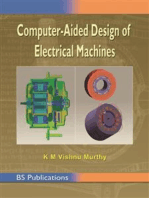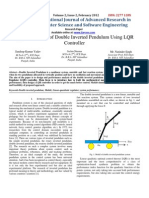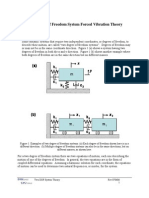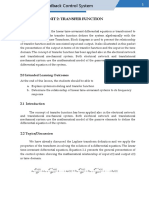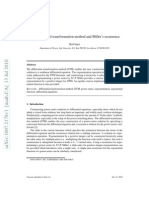State Space Model of A Mechanical System in Matlab Simulink PDF
State Space Model of A Mechanical System in Matlab Simulink PDF
Uploaded by
necromareCopyright:
Available Formats
State Space Model of A Mechanical System in Matlab Simulink PDF
State Space Model of A Mechanical System in Matlab Simulink PDF
Uploaded by
necromareOriginal Title
Copyright
Available Formats
Share this document
Did you find this document useful?
Is this content inappropriate?
Copyright:
Available Formats
State Space Model of A Mechanical System in Matlab Simulink PDF
State Space Model of A Mechanical System in Matlab Simulink PDF
Uploaded by
necromareCopyright:
Available Formats
Procedia Engineering 48 ( 2012 ) 629 635
1877-7058 2012 Published by Elsevier Ltd.Selection and/or peer-review under responsibility of the Branch Ofce of Slovak Metallurgical Society at
Faculty of Metallurgy and Faculty of Mechanical Engineering, Technical University of Koice
doi: 10.1016/j.proeng.2012.09.563
MMaMS 2012
State-Space model of a mechanical system in MATLAB/Simulink
Peter Sivk
a
*, Darina Hroncov
a
a
Technical University of Koice, Faculty of Mechanical Engineering, Letn 9, 042 00 Koice, Slovak republic
Abstract
This paper describes solution of the equations of motion of the mechanical system by using State-Space blocks in MATLAB/Simulink. It
deals with the mechanical system with two degrees of freedom. State-Space block solution is compared with solution made by an
alternative approach, using so called Transfer Fcn block. Equations are also derived by Newton's second law, Lagranges equations and
the Hamiltons equations.
2012 The Authors. Published by Elsevier Ltd.
Selection and/or peer-review under responsibility of the Branch Office of Slovak Metallurgical Society at Faculty of Metallurgy and
Faculty of Mechanical Engineering, Technical University of Koice.
Keywords: State Space, Transfer Function, kinetic energy, potential energy, Matlab, Simulink.
Nomenclature
m
1
, m
2
masses
k
1
, k
2
stiffness of the springs
b
1
, b
2
coefficients of viscous damping
H Hamiltons function
E
k
kinetic energy
E
p
potential energy
D Rayleighs dissipative function
p
i
momentum of the i-th member
x state vector
y output vector
u input vector
A state matrix
B input matrix
C output matrix
D feedforward matrix
1. Introduction
In the first part we derived the equations of motion of the mechanical system with two degrees of freedom using the
* Corresponding author. Tel.: +421556022466.
E-mail address: peter.sivak@tuke.sk.
Available online at www.sciencedirect.com
2012 Published by Elsevier Ltd.Selection and/or peer-review under responsibility of the Branch Ofce of Slovak Metallurgical Society at
Faculty of Metallurgy and Faculty of Mechanical Engineering, Technical University of Koice
630 Peter Sivk and Darina Hroncov / Procedia Engineering 48 ( 2012 ) 629 635
second Newton's law. Next the these equations are derived by Lagrange's equations of the second kind. Finally we
determine the state equations by using Hamilton's equations [2]. The aim is to describe the use of State-Space blocks and
Transfer Fcn of the dynamic system in Matlab/Simulink. The obtained results are compared with direct solution in Matlab.
The results are presented in graphical form.
2. Newtons Equations
In this section we describe the compilation of equations of motion of the mechanical system with two degrees of freedom
with Lagrange equations of the second kind and the Hamilton equations. These equations are then solved in Matlab with
Runge-Kutta method. The results provide information about displacement, velocity and acceleration of individual members
of the mechanical system as a function of time. A harmonically variable force F(t) is used for the model excitation (Fig. 1).
k
b
m
k
b
m
(L)
x (L), v (L)
1 1
x (L), v (L)
z z
1
1
1
z
z
z
Fig. 1. Damped mass-spring system with two degrees of freedom.
We consider a mechanical system with two degrees of freedom of movement (Fig. 1), which consists of bodies with
masses m
1
and m
2
connected with springs with stiffnesses k
1
and k
2
and dampers with linear damping coefficients b
1
and b
2
connected to a rigid frame [5-10]. The system performs linear motion in direction of springs and dampers axes. The weights
of the springs are not considered. A harmonically variable force F(t) = F
0
sin(t) is used for the model excitation. The
respective members perform linear forced oscillating motion. Equations of the motion:
( ) t F F F F F x m
d r d r
+ + + =
2 2 1 1 1 1
, (1)
2 2 2 2 d r
F F x m = , (2)
reaction forces in the springs
( )
1 2 2 1 1
. , .
2 1
x x k F x k F
r r
= = , (3)
damping forces
( )
1 2 2 1 1
. , .
2 1
x x b F x b F
d d
= = . (4)
The aim is to determine the response of the oscillating system - displacements x
1
=x
1
(t), x
2
=x
2
(t). This, however, requires
to solve a system of differential equations. For a mechanical system with two degrees of freedom it is a nonhomogeneous
system of 2nd order linear differential equations with constant coefficients.
3. Lagranges equations
Next we determine the equations of motion of the above mentioned system using Lagranges equations of the second
kind. For this we need to determine kinetic and potential energy of the system and the Rayleigh dissipative function.
If we define the generalized coordinates as
2 2 1 1
, x q x q = = , and the generalized velocities as
2 2 1 1
, x q x q = = , the
kinetic energy of the system is:
,
2
1
2
1
2
2 2
2
1 1
x m x m E
k
+ = (5)
potential energy
( ) ,
2
1
2
1
2
1 2 2
2
1 1
x x k x k E
p
+ = (6)
Rayleighs dissipative function
( ) ,
2
1
2
1
2
1 2 2
2
1 1
x x b x b D + = (7)
generalized forces
0 ), (
2 1
= =
b b
Q t F Q . (8)
631 Peter Sivk and Darina Hroncov / Procedia Engineering 48 ( 2012 ) 629 635
Substituting the generalized coordinates the potential energy of the system:
( ) ,
2
1
2
1
2
1
2
1
2
1
2
1 2 2 1 2
2
2 2
2
1 1
2
1 2 2
2
1 1
x k x x k x k x k x x k x k E
p
+ + = + = (9)
Rayleighs dissipative function
( ) .
2
1
2
1
2
1
2
1
2
1
2
1 2 2 1 2
2
2 2
2
1 1
2
1 2 2
2
1 1
x b x x b x b x b x x b x b D + + = + = (10)
Lagranges equations of the second kind for the mechanical system (Fig. 2) are:
,
1
1 1 1 1
b
p
k k
Q
x
D
x
E
x
E
x
E
dt
d
+
(11)
2
2 2 2 2
b
p
k k
Q
x
D
x
E
x
E
x
E
dt
d
+
. (12)
After substitution of the partial derivations we obtain equations of motion in the form:
( ) ( ) ( ) ,
1
1
1 2
1
2
1
1
1
1 2
1
2
1
1
1
1
t F
m
x x
m
k
x
m
k
x x
m
b
x
m
b
x + + + = (13)
( ) ( )
1 2
2
2
1 2
2
2
2
x x
m
k
x x
m
b
x = , (14)
where
2 1
, x x are velocities and
2 1
, x x are accelerations of the masses m
1
and m
2
. These equations are linear differential
equations of second order with constant coefficients.
4. Hamiltons equations
The Hamiltons function H = H (q, p), which is the sum of kinetic and potential energies can be used to determine the
equations of motion of the mechanical system with two degrees of freedom. It has a form:
,
p k
E E H + = (15)
.
2
1
2
1
2
1
2
1
2
1
2
1 2 2 1 2
2
2 2
2
1 1
2
2 2
2
1 1
x k x x k x k x k x m x m H + + + + = (16)
Then Hamilton's equations:
,
i
i
p
H
t
x
(17)
i
b i
i
i
Q Q
x
H
t
p
+ +
. (18)
State variables of the mechanical system from Fig. 1 are the displacements x
1
, x
2
and momentum p
1
, p
2
. The kinetic
energy expressed by the momentum is:
i
i
i
i
i i k
m
p
m
p
m x m E
i
i
2 2
1
2
1
2
2
2
=
= = , (19)
potential energy
632 Peter Sivk and Darina Hroncov / Procedia Engineering 48 ( 2012 ) 629 635
2
2
1
i i p
x k E = , (20)
Rayleighs dissipative function
2
2
1
i i
x b D = . (21)
Generalized linear force for viscous damping is expressed by Rayleigh's dissipative function relationship:
,
i
i
x
D
Q
= i=1,2 , (22)
generalized forces
( ) 0 ,
2 1
= =
b b
Q t F Q . (23)
Equations of the mechanical system are obtained in the form:
1
1
) (
p
H
t d
t x d
= , (24)
2
2
) (
p
H
t d
t x d
= , (25)
( )
1
1
1
1
b
Q Q
x
H
t d
t p d
+ +
= , (26)
( )
2
2
2
2
b
Q Q
x
H
t d
t p d
+ +
= . (27)
In matrix form:
( )
( )
( )
( )
( )
( )
( )
( )
( )
0
. .
1
1
1
1
2
1
2
1
t F
t p
t p
t x
t x
t d
t p d
t d
t p d
t d
t x d
t d
t x d
B A
, (28)
state vector is
( ) ( ) ( ) ( ) [ ]
T
t p t p t x t x
2 1 2 1
, , , = X . (29)
Equations of the mechanical system in matrix form for p
i
(t)=m
i
.v
i
(t) , i=1,2 are:
( )
( )
( )
( )
( )
( )
( )
( )
( )
0
. .
2
1
2
1
2
1
2
1
t F
t v
t v
t x
t x
t d
t v d
t d
t v d
t d
t x d
t d
t x d
B A
(30)
633 Peter Sivk and Darina Hroncov / Procedia Engineering 48 ( 2012 ) 629 635
and state vector
( ) ( ) ( ) ( ) [ ]
T
t v t v t x t x
2 1 2 1
, , , = X . (31)
We have determined the equations of state of a mechanical system with two degrees of freedom for the state variables x
1
,
x
2
and v
1
, v
2
of respective objects with masses m
1
, m
2
.
5. State Space equation in MATLAB/Simulink
Solution of the nonhomogenous system of differential equations of a mechanical system with two degrees of freedom is
first done in Matlab/Simulink using State-Space and Transfer Fcn blocks [7], [2].
In control engineering, a state space representation is a mathematical model of a physical system as a set of input, output
and state variables related by first-order differential equations. To abstract from the number of inputs, outputs and states, the
variables are expressed as vectors. Additionally, if the dynamical system is linear and time invariant, the differential and
algebraic equations may be written in matrix form. The state space representation (also known as the "time-domain
approach") provides a convenient and compact way to model and analyze systems with multiple inputs and outputs. Unlike
the frequency domain approach, the use of the state space representation is not limited to systems with linear components
and zero initial conditions. "State space" refers to the space whose axes are the state variables. The state of the system can
be represented as a vector within that space.
The most general state-space representation of a linear system with u inputs, y outputs and n state variables is written in
the following form (Fig. 2):
[W
\W XW
LQSXW RXWSXW
LQWHUQDOVWDWH
&
$
%
'
[W
Fig. 2. Block diagram representation of the state space equations.
For State-Space equations in form [7]:
( ) ( ) ( ) t t t u B x A x . . + = , (32)
( ) ( ) ( ) t t t u D x C y . . + = . (33)
We obtain:
0
. .
2
1
2
1
2
1
2
1
F
v
v
x
x
v
v
x
x
B A
, (34)
=
0
. .
2
1
2
1
F
v
v
x
x
y D C . (35)
A, B, C, D are the respective matrices of the mechanical system defined as follows:
634 Peter Sivk and Darina Hroncov / Procedia Engineering 48 ( 2012 ) 629 635
( ) ( )
,
1 0 0 0
0 1 0 0
2
2
2
2
2
2
2
2
1
2
1
2 1
1
2
1
2 1
+
=
m
b
m
b
m
k
m
k
m
b
m
b b
m
k
m
k k
A ,
1
0
0
1
0 0
0 0
2
1
=
m
m
B ,
0 0 1 0
0 0 0 1
= C
=
0 0
0 0
D . (36)
The input u(t) is represented by the excitation forces:
( )
( )
=
0
t F
t u . (37)
And the output y(t) is represented by the displacements x
1
(t) and x
2
(t):
( )
( )
( )
( )
( )
=
t v
t v
t x
t x
t
2
1
2
1
.
0 0 1 0
0 0 0 1
y . (38)
Parameters used in the process of solution (Fig. 3) of the mechanical system were: m
1
=70 kg, m
2
=140 kg, k
1
=500 N/m,
k
2
=250 N/m, b
1
=10 N/(m.s
-1
), b
2
=50 N/(m.s
-1
), F
0
=100 N, =2 rad.s
-1
, initial conditions x(0) = 0 m, v(0) = 0 m/s, [1-4].
Fig. 3 The block diagram in Simulink
Output in Scope block - displacements x
1
, x
2
and velocities v
1
, v
2
are shown in Fig. 4 .
(a)
0 2 4 6 8 10
-0.25
-0.2
-0.15
-0.1
-0.05
0
0.05
0.1
0.15
0.2
0.25
Displacement x1 a x2 of the member 1 and 2
t [s]
x
1
[
m
]
,
x
2
[
m
]
x1=x1(t)
x2=x2(t)
(b)
0 2 4 6 8 10
-0.5
-0.4
-0.3
-0.2
-0.1
0
0.1
0.2
0.3
0.4
Velocity v1 and v2 of the member 1 a 2
t [s]
v
1
[
m
/
s
]
,
v
2
[
m
/
s
]
v1=v1(t)
v2=v2(t)
Fig. 4. Simulation resuts in Simulink for (a) displacement x
1
(t), x
2
(t) and (b) velocity v
1
(t), v
2
(t).
6. Transfer Fcn model
The obtained State-Space representation of the mechanical system can be in the Matlab easily transformed to an
equivalent Transfer Fcn model (Fig. 5) by ss2tf function. The syntax of this command in Matlab is:
635 Peter Sivk and Darina Hroncov / Procedia Engineering 48 ( 2012 ) 629 635
>> [num, den]=ss2tf(A,B,C,D,1)
Fig. 5 The block diagram Transfer Fcn
Solving the mechanical system by using State-Space equations and the Transfer Function (Fig. 6) gave the same results,
as we anticipated.
0 2 4 6 8 10
-0.25
-0.2
-0.15
-0.1
-0.05
0
0.05
0.1
0.15
0.2
0.25
Displacement x1 a x2 with Transfer Fcn
t [s]
x
1
[
m
]
,
x
2
[
m
]
x1=x1(t)
x2=x2(t)
Fig. 6 Simulation results in Simulink with Transfer Fcn
7. Conclusion
The paper describes the compilation of the equations of motion of a mechanical system with two degrees of freedom in
Matlab/Simulink by using State - Space and Transfer function.
Results are shown graphically. The calculation is done for a model with force excitation in Matlab and Simulink, to
illustrate the methodology.
The contribution of this work is primarily educational, especially in the field of Applied Mechanics and Mechatronics.
The above procedure presents the possibility of practical implementation of this solution to simple equations of motion of a
mechanical system in Matlab/Simulink.
Acknowledgement
This contribution is the result of the project implementation: Center for research of control of technical, environmental
and human risks for permanent development of production and products in mechanical engineering (ITMS: 26220120060)
supported by the Research & Development Operational Program funded by the ERDF. This work was also supported in part
by the Ministry of Education of the Slovakia Foundation under Grant VEGA 1/1205/12 and Grant VEGA 1/0289/11.
References
[1] Vavrinkov, V., Hroncov, D., 2008. Modelovanie kmitania v prostred Simulink. Acta Mechanica Slovaca, Koice, Slovakia. s. 869-876. ISSN
1335-2393.
[2] Gmiterko, A., 2004. Mechatronics. Emilenia, Koice, Slovakia.
[3] Karban, P., 2006. Vpoty a simulace v programech Matlab a Simulink. Computer Press, Brno, esko. ISBN 80-251-1301-9.
[4] Kozk, ., Kajan, S., 2006. Matlab Simulink I. STU Bratislava, Bratislava, Slovensko.
[5] Ogatha, K., 1978. System Dynamics. Prentice Hall, Inc., Englewood Cliffs, New Jersey.
[6] Stradiot, J., Michalek, M., Mudrk, J., Slavkovsk, J., 1991. Dynamika strojov. Alfa, Bratislava. Slovakia. ISBN 80-05-00756-6.
[7] Horek, P., 1999. Systems and models. Nakladatelstv VUT, Praha, esko.
[8] Sega, ., Sega, J., 2011. Modelling and Optimization of Vehicle suspension with Magnetorheological Dampers, In: 7th International Conference
Dynamics of Rigid and Deformable Bodies 2011, st nad Labem , 2011. ISBN 978-80-7414-376-2.
[9] Hroncov, D., 2012. Studies of compatible software tools for abstract and concrete design of mechatronic systems and linking them for the purpose of
logical and physical modeling, Dissertation thesis, Koice.
[10] Volek, J., Sega, ., Soukup, J., 2007. Analytick vpoet vertiklnch posuv trolejbusu koda 21 Tr pi pejezdu soustavy pekek dle SN ve
stanovench bodech. Vzkumn zprva . 05/07, FVTM UJEP v st nad Labem. esko.
You might also like
- Introductory Applications of Partial Differential Equations: With Emphasis on Wave Propagation and DiffusionFrom EverandIntroductory Applications of Partial Differential Equations: With Emphasis on Wave Propagation and DiffusionNo ratings yet
- Nonlinear Dynamic in Engineering by Akbari-Ganji’S MethodFrom EverandNonlinear Dynamic in Engineering by Akbari-Ganji’S MethodNo ratings yet
- State-Space Model of A Mechanical System in MATLAB/Simulink: Procedia Engineering December 2012Document8 pagesState-Space Model of A Mechanical System in MATLAB/Simulink: Procedia Engineering December 2012Aniket SafariNo ratings yet
- Chapter-6: Energy Method (Lagrange's Method)Document35 pagesChapter-6: Energy Method (Lagrange's Method)ideepujNo ratings yet
- Mathematical Modeling of Mechanical Systems and Electrical SystemsDocument49 pagesMathematical Modeling of Mechanical Systems and Electrical SystemsMary DunhamNo ratings yet
- International Conference NeruDocument10 pagesInternational Conference NeruNeeru SinghNo ratings yet
- Chapter 2 - Mathematical ModellingDocument84 pagesChapter 2 - Mathematical ModellingDyrul SyaznanNo ratings yet
- HHT Alpha MethodDocument22 pagesHHT Alpha MethodSasi Sudhahar ChinnasamyNo ratings yet
- Lecture Chapter1 8newDocument188 pagesLecture Chapter1 8newDinuka RavimalNo ratings yet
- Vibration of Two Degree of Freedom SystemDocument23 pagesVibration of Two Degree of Freedom SystemDewa Ayu Mery AgustinNo ratings yet
- Chapter 2Document27 pagesChapter 2hailegebreselassie24No ratings yet
- Modal AnalysisDocument40 pagesModal AnalysisSumit Thakur100% (1)
- Handout M.4 - Solutions of Ordinary Differential Equations: F T KX T X C T X MDocument15 pagesHandout M.4 - Solutions of Ordinary Differential Equations: F T KX T X C T X MTushar DeshpandeNo ratings yet
- Optimal Control of Double Inverted Pendulum Using LQR ControllerDocument4 pagesOptimal Control of Double Inverted Pendulum Using LQR ControllerSachin SharmaNo ratings yet
- CD Paper Pag 277Document8 pagesCD Paper Pag 277Anonymous lEBdswQXmxNo ratings yet
- Dieu Khien He Thong Bi Trong Tu TruongDocument5 pagesDieu Khien He Thong Bi Trong Tu TruongNinhĐứcThànhNo ratings yet
- The Simplified Dynamic Model of A Robot Manipulator: 1 Problem DescriptionDocument6 pagesThe Simplified Dynamic Model of A Robot Manipulator: 1 Problem DescriptionRudnei BarbosaNo ratings yet
- Modeling of Dynamic SystemsmesinDocument19 pagesModeling of Dynamic SystemsmesinRifqi Bustanul FaozanNo ratings yet
- Theory For Two Degree of Freedom SystemsDocument4 pagesTheory For Two Degree of Freedom SystemsRajiv ThambotheranNo ratings yet
- Nonlinear Dynamics of Two Degree of Freedom Systems With Linear and Nonlinear Stiffnesses (Bayat, Et Al. 2013)Document10 pagesNonlinear Dynamics of Two Degree of Freedom Systems With Linear and Nonlinear Stiffnesses (Bayat, Et Al. 2013)Jose ManuelNo ratings yet
- Logistic Map Circuit PDFDocument8 pagesLogistic Map Circuit PDFmenguemengueNo ratings yet
- Modelling and Simulation of Mechatronic SystemsDocument19 pagesModelling and Simulation of Mechatronic SystemsEnes Umur GökçekNo ratings yet
- Department of Electrical Engineering EE361L: Control Systems LabDocument16 pagesDepartment of Electrical Engineering EE361L: Control Systems Labshryr.scorpioNo ratings yet
- A New Bifurcation Analysis For Power System Dynamic Voltage Stability StudiesDocument6 pagesA New Bifurcation Analysis For Power System Dynamic Voltage Stability StudiesRathinaKumarNo ratings yet
- Notesinstalment2 PDFDocument26 pagesNotesinstalment2 PDFVikas NarangNo ratings yet
- Theory: Forced Vibration of Two Degrees of Freedom SystemDocument4 pagesTheory: Forced Vibration of Two Degrees of Freedom SystemettypasewangNo ratings yet
- Lagrange Equation 1Document32 pagesLagrange Equation 1Gthulasi78No ratings yet
- Mathetical ModelDocument3 pagesMathetical ModelOscar AvilesNo ratings yet
- Unit 2: Transfer Function: PrefaceDocument9 pagesUnit 2: Transfer Function: PrefaceNeans PlanterasNo ratings yet
- Electromagnetic Levitation System: An Experimental ApproachDocument7 pagesElectromagnetic Levitation System: An Experimental Approachsh1n00b1No ratings yet
- QuestionsDocument21 pagesQuestionsShreyan SinhaNo ratings yet
- Quantum PhysicsDocument17 pagesQuantum PhysicsAgnivesh SharmaNo ratings yet
- A New Predictor-Corrector Method For Optimal Power FlowDocument5 pagesA New Predictor-Corrector Method For Optimal Power FlowfpttmmNo ratings yet
- Predictive Control AlgorithmDocument7 pagesPredictive Control AlgorithmIngole DeepakNo ratings yet
- Dynamic System Analysis and Simulation - 19Document7 pagesDynamic System Analysis and Simulation - 19Gabriel CaldasNo ratings yet
- Non Linear System and LinearizationDocument20 pagesNon Linear System and LinearizationGianluca MustilloNo ratings yet
- MAE 376 ProjectDocument6 pagesMAE 376 ProjectJenna HagenNo ratings yet
- Classical HamiltonianDocument4 pagesClassical Hamiltonianbatenas1No ratings yet
- Real Modes ExtractionDocument10 pagesReal Modes ExtractionrenatobellarosaNo ratings yet
- Lab 03 Simulink 2018 Part 2Document12 pagesLab 03 Simulink 2018 Part 2Reem GheithNo ratings yet
- Global Stiffness MatrixDocument13 pagesGlobal Stiffness Matrixasfsaf0% (1)
- Dfig Book PDFDocument29 pagesDfig Book PDFSrinivasan PurushothamanNo ratings yet
- ControlofaNonlinearandLinearizedModelofSelf balancingElectricMotorcycle PDFDocument13 pagesControlofaNonlinearandLinearizedModelofSelf balancingElectricMotorcycle PDFPhương Hoàng VănNo ratings yet
- The Differential Transformation Method and Miller's RecurrenceDocument5 pagesThe Differential Transformation Method and Miller's Recurrencehalf26dNo ratings yet
- State Space Representation Part-1Document47 pagesState Space Representation Part-1SingappuliNo ratings yet
- RME30002 Control and Automation AssignmentDocument2 pagesRME30002 Control and Automation AssignmentIrtiza IshrakNo ratings yet
- HW1 EE381 Fall 2023Document2 pagesHW1 EE381 Fall 2023zsudeatNo ratings yet
- Aircraft Dynamic Stability AnalysisDocument29 pagesAircraft Dynamic Stability AnalysisIaNickNo ratings yet
- Design and Simulation of Control System For Bearingless Synchronous Reluctance Motor PDFDocument5 pagesDesign and Simulation of Control System For Bearingless Synchronous Reluctance Motor PDFKrishnam NaiduNo ratings yet
- Solutions To Selected Questions From Assignment 2: T M J T M Z Z JDocument5 pagesSolutions To Selected Questions From Assignment 2: T M J T M Z Z JDoug Shi-DongNo ratings yet
- Control Lec 02 - 2021 - Course IDocument9 pagesControl Lec 02 - 2021 - Course Iyasa1990No ratings yet
- Student Solutions Manual to Accompany Economic Dynamics in Discrete Time, second editionFrom EverandStudent Solutions Manual to Accompany Economic Dynamics in Discrete Time, second editionRating: 4.5 out of 5 stars4.5/5 (2)
- Nonlinear Control Feedback Linearization Sliding Mode ControlFrom EverandNonlinear Control Feedback Linearization Sliding Mode ControlNo ratings yet
- Multibody Dynamics Modeling and System Identification For A Quarter-Car Test Rig With McPherson Strut Suspension PDFDocument122 pagesMultibody Dynamics Modeling and System Identification For A Quarter-Car Test Rig With McPherson Strut Suspension PDFnecromareNo ratings yet
- Jon Fernandez de Antona Beng Project Excerpt3Document112 pagesJon Fernandez de Antona Beng Project Excerpt3Ramadan Duraku0% (1)
- State Space Modeling, System Identification and Control of A 4th Order Rotational Mechanical System PDFDocument116 pagesState Space Modeling, System Identification and Control of A 4th Order Rotational Mechanical System PDFnecromareNo ratings yet
- Flip-Chip Packaging Using PES (Printing Encapsulation Systems) and Underfill Epoxy ResinDocument4 pagesFlip-Chip Packaging Using PES (Printing Encapsulation Systems) and Underfill Epoxy ResinnecromareNo ratings yet
- Supervised Machine Learning Techniques For Efficient Network Intrusion DetectionDocument9 pagesSupervised Machine Learning Techniques For Efficient Network Intrusion Detectionسلام امانNo ratings yet
- Lesson Notes - Decision 1 Lesson 7 - Linear Programming: Formulating A Problem As A Linear Programming ProblemDocument4 pagesLesson Notes - Decision 1 Lesson 7 - Linear Programming: Formulating A Problem As A Linear Programming ProblemsparrowjakazzNo ratings yet
- Linear Programming: Special Cases in Simplex Metho: 8.1 DegeneracyDocument7 pagesLinear Programming: Special Cases in Simplex Metho: 8.1 DegeneracySubhash KorumilliNo ratings yet
- Business Data Mining Week 4Document12 pagesBusiness Data Mining Week 4pm6566No ratings yet
- Name: Cabarrubias, Jonathan A. Year & Section: 1Document5 pagesName: Cabarrubias, Jonathan A. Year & Section: 1Angelo DejanNo ratings yet
- Finite Difference MethodDocument16 pagesFinite Difference MethodMartua Mario100% (1)
- Obtaining Super-Resolution Images by Combining Low-Resolution Images With High-Frequency Information Derivedfrom Training ImagesDocument13 pagesObtaining Super-Resolution Images by Combining Low-Resolution Images With High-Frequency Information Derivedfrom Training ImagesAnonymous Gl4IRRjzNNo ratings yet
- Fuzzy Logic and Neural NetworkDocument1 pageFuzzy Logic and Neural Networkdroy21No ratings yet
- Caballero Krizah Marie C. Bsa 1a Mngtsci Activity 1 End TermDocument5 pagesCaballero Krizah Marie C. Bsa 1a Mngtsci Activity 1 End TermDENZ RAYMOND LACUESTANo ratings yet
- 2022 - 04 - 22 Direct Time Study ProblemsDocument14 pages2022 - 04 - 22 Direct Time Study Problemsaqsa imranNo ratings yet
- DUKPTDocument19 pagesDUKPTmail4290No ratings yet
- Implementation of Rsa Key Generation Based On Rns Using VerilogDocument5 pagesImplementation of Rsa Key Generation Based On Rns Using VerilogxsantkombaNo ratings yet
- Published Indoor NavigationDocument6 pagesPublished Indoor NavigationsaiNo ratings yet
- Store Sales Challenge: Time Series Analysis For Sales ForecastDocument11 pagesStore Sales Challenge: Time Series Analysis For Sales Forecastnaveen maniNo ratings yet
- CS772 Lec7Document13 pagesCS772 Lec7juggernautjhaNo ratings yet
- AnswersDocument11 pagesAnswersSean TuasonNo ratings yet
- P, Pi & PID Controller: By:-Karan SatiDocument16 pagesP, Pi & PID Controller: By:-Karan Satiaditee saxenaaNo ratings yet
- 2.2. Substitution TechniquesDocument3 pages2.2. Substitution Techniquess.keerthanaNo ratings yet
- Practice Problems Set2 InstructionsDocument3 pagesPractice Problems Set2 InstructionsHakimi kamini0% (1)
- Content-Based Filtering and Hybrid Methods: Francesco RicciDocument30 pagesContent-Based Filtering and Hybrid Methods: Francesco RicciAnonymous rsGzBBiqkNo ratings yet
- Effect of Word Embedding Vector Dimensionality On Sentiment Analysis Through Short and Long TextsDocument8 pagesEffect of Word Embedding Vector Dimensionality On Sentiment Analysis Through Short and Long TextsIAES IJAINo ratings yet
- Data Structures and Algorithms: Kurt Mehlhorn Peter SandersDocument55 pagesData Structures and Algorithms: Kurt Mehlhorn Peter SandersFred JohnsonNo ratings yet
- Advanced Database Chapter Two Query Processing and OptimizationDocument43 pagesAdvanced Database Chapter Two Query Processing and OptimizationbayisadamisseNo ratings yet
- Decap776 P 1Document6 pagesDecap776 P 1pb4444335No ratings yet
- A Review of Deep Learning Methods and Applications For PDFDocument14 pagesA Review of Deep Learning Methods and Applications For PDFershadNo ratings yet
- MODULE 4 - Laplace TransformsDocument6 pagesMODULE 4 - Laplace TransformsIrene HugoNo ratings yet
- Statistics 302Document29 pagesStatistics 302KhadijaNo ratings yet
- Exercise Sheet-2Document3 pagesExercise Sheet-2pauline chauveauNo ratings yet
- Message Authentication Code and Digital Signatures - Technical ReportDocument33 pagesMessage Authentication Code and Digital Signatures - Technical ReportRam KrishnaNo ratings yet
- Ge8151 PSPP Jan 2019 Rejinpaul PDFDocument1 pageGe8151 PSPP Jan 2019 Rejinpaul PDFsathriyan sathriyanNo ratings yet

